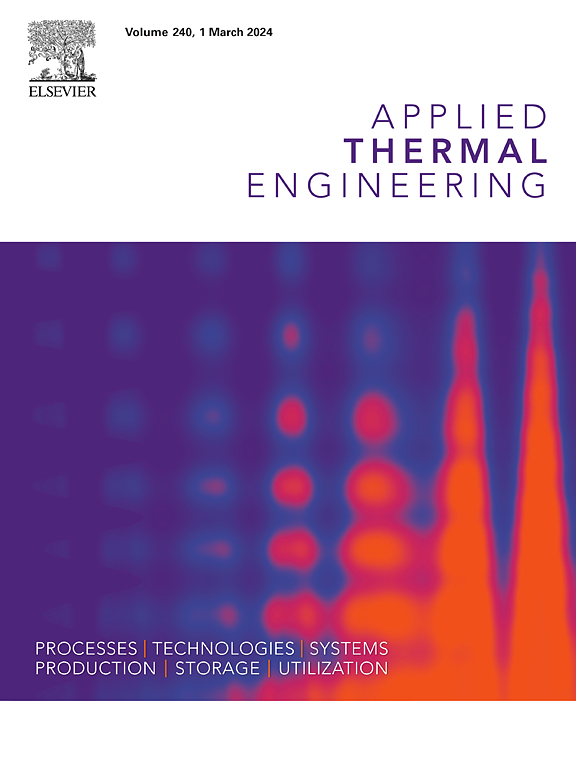Experimental and numerical study of seawater freezing coupled with ice growth dynamics and heat/mass transfer
IF 6.9
2区 工程技术
Q2 ENERGY & FUELS
引用次数: 0
Abstract
Seawater cold thermal energy storage offers high efficiency, environmental benefits, and abundant availability, making it promising for load shifting and energy system optimization. However, current seawater freezing models struggle to accurately capture the multiscale dynamics of ice formation and associated heat and mass transfer, limiting system performance improvement. To address this, a multiscale seawater freezing model is developed by coupling microscopic ice crystal growth mechanisms with macroscopic refrigeration system behavior. The model investigates seawater’s thermophysical transport and freezing kinetics. Ice crystal growth parameters are extracted through microscale simulations, and a kinetic model is constructed using the Arrhenius equation and hybrid particle swarm optimization (HPSO). This kinetic model is integrated into a system-level simulation to predict the freezing process in a cold storage tank under realistic conditions. The model achieves high accuracy, with maximum errors of 0.9 °C for water temperature, 4 mm for ice thickness, 1.5 °C for refrigerant outlet temperature, and 0.02 MPa for outlet pressure. Compared with the traditional enthalpy-porosity model (EPM), the proposed model reduces the water temperature error by 40 % and improves ice thickness accuracy, reducing the maximum error from 15 mm to 4 mm. Furthermore, salinity significantly influences salt rejection, temperature evolution, heat transfer coefficient, cooling capacity, and thermal storage performance. A 3 % salinity seawater achieves the best performance due to a favorable balance between temperature difference and heat transfer efficiency. This study provides theoretical insights and technical support for enhancing seawater freezing models and optimizing system-level cold thermal storage design.
海水冻结与冰生长动力学和传热传质耦合的实验与数值研究
海水冷热储能具有效率高、环境效益好、可用性强等优点,在负荷转移和能源系统优化方面具有广阔的应用前景。然而,目前的海水冻结模型难以准确捕捉冰形成和相关的热量和质量传递的多尺度动力学,限制了系统性能的提高。为了解决这一问题,将微观冰晶生长机制与宏观制冷系统行为相结合,建立了一个多尺度海水冻结模型。该模型研究了海水的热物理输运和冻结动力学。通过微尺度模拟提取了冰晶生长参数,并利用Arrhenius方程和混合粒子群优化(HPSO)建立了冰晶生长动力学模型。将该动力学模型集成到系统级仿真中,以预测实际条件下冷库中的冻结过程。模型精度高,水温最大误差0.9°C,冰厚最大误差4mm,制冷剂出口温度最大误差1.5°C,出口压力最大误差0.02 MPa。与传统的焓孔模型(EPM)相比,该模型将水温误差降低了40%,并提高了冰厚精度,最大误差从15 mm减小到4 mm。此外,盐度显著影响盐的排出、温度演变、换热系数、制冷量和蓄热性能。在盐度为3%的海水中,由于温差和换热效率之间的良好平衡,达到了最佳性能。该研究为完善海水冻结模型和优化系统级冷蓄热设计提供了理论见解和技术支持。
本文章由计算机程序翻译,如有差异,请以英文原文为准。
求助全文
约1分钟内获得全文
求助全文
来源期刊

Applied Thermal Engineering
工程技术-工程:机械
CiteScore
11.30
自引率
15.60%
发文量
1474
审稿时长
57 days
期刊介绍:
Applied Thermal Engineering disseminates novel research related to the design, development and demonstration of components, devices, equipment, technologies and systems involving thermal processes for the production, storage, utilization and conservation of energy, with a focus on engineering application.
The journal publishes high-quality and high-impact Original Research Articles, Review Articles, Short Communications and Letters to the Editor on cutting-edge innovations in research, and recent advances or issues of interest to the thermal engineering community.
 求助内容:
求助内容: 应助结果提醒方式:
应助结果提醒方式:


